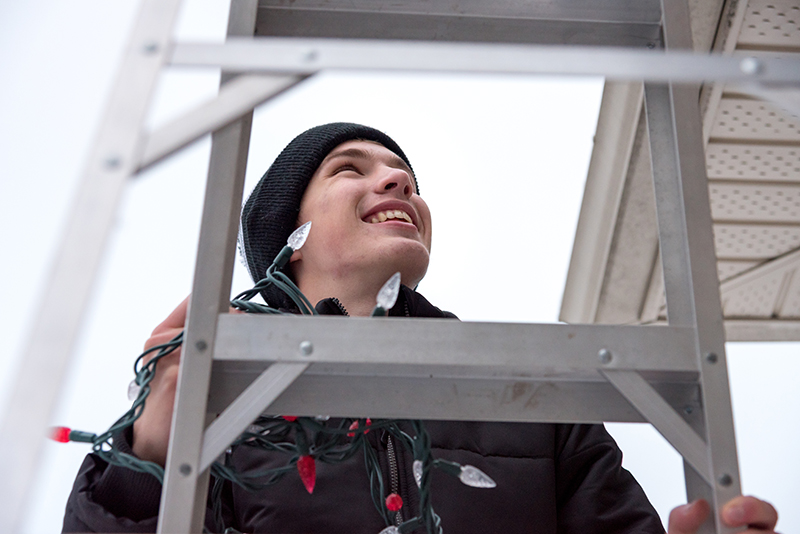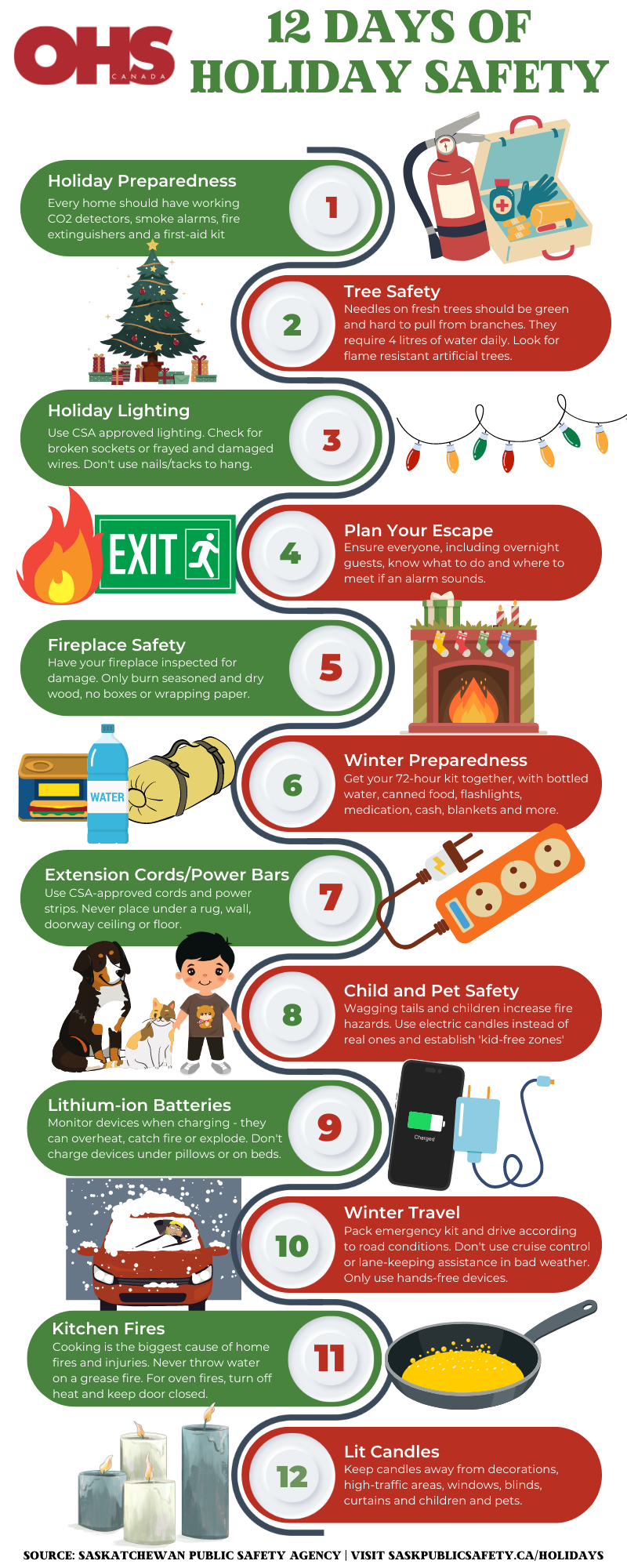
The 12 days of holiday safety: Tips, advice for the home
December 13, 2022
By
OHS Canada

(Brian/Adobe Stock)
By Saskatchewan Public Safety Agency/OHS Canada
As more time is spent indoors during the holiday season, the risk of fire increases. The Saskatchewan Public Safety Agency (SPSA) is encouraging people to participate in the 12 Days of Holiday Safety campaign to keep them and their families safe this holiday season.
See OHS Canada’s infographic below.
Day 1: Holiday Preparedness
Ensure your home is equipped to celebrate the holiday safely. Each home should have a working carbon monoxide detector, smoke alarm, fire extinguisher and a first-aid kit.
Smoke alarms and carbon monoxide detectors should be installed according to manufacturer directions and tested monthly.
Make sure you inspect your fire extinguishers. They should be inspected monthly and a certified technician should check it each year.
Maintain your first-aid kit by checking that each item is in good working order, has not deteriorated and is within its expiry date. Items should be replaced as soon as possible after they have been used.
Day 2: Tree Safety
If you use a real tree this holiday season, make sure it’s fresh. It should be green with needles that are hard to pull from the branches and do not break when bent between your fingers. Real trees require up to four litres of water daily, and the base of the trunk should be in water at all times. A dry tree can quickly ignite.
If you use an artificial tree, ensure it is labeled as flame resistant. This does not mean the tree won’t catch fire, but it does indicate that the tree will resist burning and should extinguish quickly. Trim your tree using flame-resistant or non-combustible decorations.
Trees should be placed away from high-traffic areas, doorways, heating vents, fireplaces, space heaters, candles and other ignition sources.
 Day 3: Holiday Lighting
Day 3: Holiday Lighting
Before you put your holiday lights up, check to see if they have broken sockets, frayed or damaged wiring, or loose connections. Damaged or frayed lights should be disposed of.
Always use lights that are CSA approved. Make sure that you only use indoor lights inside — and outdoor lights outside.
When hanging lights outside, use insulated staples or specially designed hooks, not nails or tacks. Do not puncture light strands with staples or nails.
Never use lights on a metallic tree. The tree can become charged with electricity from faulty lights and you may be electrocuted if you touch it.
Follow the manufacturer’s instructions on the number of light strands that can be safely connected to a single outlet. When you leave the house or go to bed, shut off all indoor holiday lights.
Day 4: Plan Your Escape
A fire escape plan could save your life. It’s important that everyone, including overnight guests, are familiar with your home escape plan. Everyone must know what to do and where to go when the smoke alarm sounds.
Plan two ways out of your home from every room so you can still leave quickly in the event one route is blocked by fire. Designate a spot outside where everyone will gather after evacuating.
Practice your home fire escape plan with all members of your household at least once a year. Provide help to younger children or older adults who may need assistance to evacuate.
Day 5: Fireplace Safety
Before you use your fireplace, ensure you have inspected it for damage. If damage is present, call a qualified professional for repairs.
When using a fireplace or woodstove, ensure there is a fresh air supply into your home.
Only use seasoned and dry wood. Never use gasoline or other flammable liquid to start a fire. Do not burn your tree, wrapping paper or cardboard boxes in your fireplace. Use a fireplace screen to control sparks.
Keep flammable objects like holiday decorations, stockings, cards, etc. at least one metre from your fireplace when in use.
Never leave your fire unattended. Clean the ashes regularly and place cool ashes in a metal container with a lid and store outside, away from flammable materials.
Day 6: Winter Preparedness
Everyone should have a winter preparedness kit for their home and vehicle in case of emergency. A household kit should contain the essentials and be able to sustain you and your family for 72 hours. An emergency kit for your vehicle should contain basic supplies to help you stay comfortable if you are stuck on the side of the road or have to wait out a storm.
Household kits should contain:
- bottled water
- canned food, energy bars and dried food (and a manual can opener)
- flashlight and batteries
- special needs items like prescription medications and infant formula
- candles and matches/lighter
- first-aid kit
- battery powered or wind-up radio
- extra keys for your car or house
- sleeping bags
- cash
- your family’s emergency plan
Vehicle emergency kits should contain:
- bottled water
- canned food, energy bars and dried food
- flashlight and batteries
- first-aid kit
- shovel
- jumper cables
- cat litter
- phone charger and battery
- reflective triangles
- blanket
- ice scraper
- matches
- tool kit
Day 7: Extension Cords and Power Strips
Buy only CSA-approved extension cords and power strips. These devices should only be used as a temporary connection. If you require more outlets, hire a qualified electrician to install them.
Before using, check for any damage. If the insulation is worn or if there is any damage to the cord or plug in, the cord should be discarded.
Never place a cord under a rug, wall, doorway, ceiling or floor. If a cord is covered, heat cannot escape, which could result in a fire. Extension cords and power strips should never be plugged into one another, and never used to power a space heater or other producing appliances.
Only use outdoor extension cords outdoors, and keep them clear of snow and standing water.
Day 8: Child and Pet Safety
Having children and pets in the home can increase the risk of a fire during the holiday season. Lit candles should be out of reach of little hands and wagging tails to avoid being knocked over. Consider using electric candles instead of real ones.
Establish a one-metre “kid-free zone” around possible burn hazards such as lit candles, fireplaces or space heaters. Children and pets are both curious and will investigate cooking appliances, candles or fires in fireplaces. Never leave them alone around an open flame.
Watch pets to make sure they don’t chew through electrical cords. Have any problems checked out by a professional.
Day 9: Lithium-ion Batteries
Lithium-ion batteries store a large amount of energy in a small amount of space and can overheat, catch fire or explode if not used properly.
Make sure to always monitor your devices when charging, and do not charge devices under your pillow, on your bed or on a couch. Always follow the manufacturer’s instructions, and only use the charging cord that came with the device.
Batteries and devices should be kept at room temperature and out of direct sunlight to prevent them from overheating.
Stop using the battery or device if you notice an odour, change in colour, too much heat, change in shape, leaking or odd noises.
When it comes time to dispose of your battery or device, do not place it in the trash. Look for a battery recycling location or contact your community for disposal instructions.
Day 10: Winter Travel
Winter travel can be dangerous in certain conditions. Before you hit the road, make sure your emergency kit is packed and check the road conditions by using the Highway Hotline app or website.
Give yourself extra time to reach your destination or stay home in bad travel conditions. Always tell someone where you are going and when you expect to arrive. Slow down in bad weather, and don’t rely on cruise control or lane-keeping assistance in winter weather.
Always remember to wear your seatbelt, and never get behind the wheel if you are tired or under the influence of drugs or alcohol. Keep your phone charged but remember not to use it while driving. Have a passenger make the call or pull over if you need to call 9-1-1.
If you are inexperienced or uncomfortable with driving in winter conditions, learn how to manage skidding and spinout situations in a safe environment by taking a winter driving course.
Day 11: Kitchen Fires
Cooking is the number one cause of home fires and home injuries. You should not use the stove or stovetop if you are tired or have consumed alcohol.
Keep anything that can catch fire – oven mitts, wooden utensils, food packaging, towels or curtains – away from the stove top. Stay in the kitchen while you are cooking and turn off the stove if you must leave.
If grease in a pot or pan catches fire, smother the flames by covering the pan with a lid, then turn off the heat. Never throw water on a grease fire. For an oven fire, turn off the heat and keep the door closed.
If you are unable to put out or if you have any doubt about fighting a small fire, just get out. When you leave, close the door behind you to help contain the fire and call 9-1-1 from outside the home.
Day 12: Lit Candles
If you use candles this holiday season, ensure they are placed away from holiday decorations, high-traffic areas, windows, blinds, curtains and areas where children or pets could knock them over. Never use lit candles on a tree or near evergreens.
Use caution when carrying a lit candle. Always use a sturdy, non-flammable candle holder big enough to collect dripping wax.
Extinguish all lit candles when you leave the room, when you go to sleep or when the candle flame is within five centimetres of the holder’s edge or decorative material.
Never use a candle if oxygen is used in the home. Candles should not be used during a power outage. Have flashlights and battery-powered lighting ready instead.
Do not leave children alone in a room with a burning candle. Matches and lighters should be kept up high and out of children’s reach.
Consider using a battery-powered flameless candle to reduce the risk of a fire.
For more information, see the 12 Days of Holiday Safety PDF.